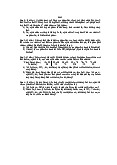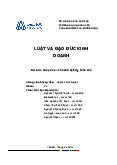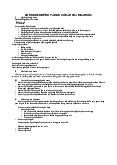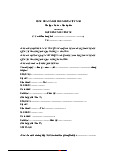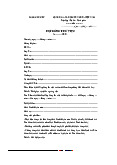



















Preview text:
Talk To Me In Korean Workbook Level 1 wri琀琀en & designed by TalkToMeInKorean Talk To Me In Korean Workbook Level 1 Contents
How to Use the Talk To Me In Korean Workbook 6 Quick guide to Hangeul 8 Lesson 1. Hello, Thank you 13
안녕하세요. 감사합니다. Lesson 2. Yes, No, What? 17 네. 아니요. Lesson 3. Good-bye, See you 20
안녕히 가세요. 안녕히 계세요.
Lesson 4. I’m sorry, Excuse me 25 죄송합니다. 저기요. Lesson 5. It’s me, What is it? 29 - 이에요/예요 Lesson 6. What is this?, This is …. 33 이거, 이거 뭐예요? Lesson 7. This, That, It 36 이, 저, 그, 거/것 Lesson 8. It’s NOT me 38 아니에요.
Lesson 9. topic,subject marking particles 42 - 은/는, - 이/가
Lesson 10. have, don’t have, there is, there isn’t 46 있어요. 없어요. Lesson 11. Please give me 50 주세요.
Lesson 12. it’s delicious, it tastes awful, thank you for the food 55
맛있어요, 맛없어요, 잘 먹었습니다. 4 Talk To Me In Korean Workbook Lesson 13. I want to … 59 - 고 싶어요
Lesson 14. What do you want to do? 62 뭐 - 고 싶어요? Lesson 15. Sino-Korean Numbers 65 일, 이, 삼, 사, … Lesson 16. Basic Present Tense 68 - 아/어/여요 Lesson 17. Past Tense 72 - 았/었/였어요 Lesson 18. Location-marking Particles 76 어디, - 에, -에서 Lesson 19. When 81 언제 Lesson 20. Native Korean numbers 85 하나, 둘, 셋, 넷, … Lesson 21. Negative Sentences 90 안, - 지 않다 Lesson 22. verbs 94 하다 Lesson 23. Who? 98 누구? Lesson 24. Why? How? 102 왜? 어떻게?
Lesson 25. From A To B, From C Until D 106 - 에서/부터 - 까지 Answers 111 5 How to Use
the Talk To Me In Korean Workbook
This workbook is designed to be used in conjunction with the TTMIK Level 1
lessons, which are available for free at www.talktomeinkorean.com. Developed
by a certi昀椀ed teacher to help you review and retain what you’ve learned in
the TTMIK lessons, this workbook contains 6 main categories of review and 13 types of exercises: Categories 1. Vocabulary review 2. Writing 3. Listening comprehension 4. Reading comprehension Types of Exercises 5. Fill in the chart 6. Dictation 1. Matching 2. Fill in the blank 3. Multiple choice 4. Dictation 5. Draw a picture 6 Talk To Me In Korean Workbook
6. Translation (Korean <-> English) 7. Short answer 8. De昀椀ne and translate 9. Conjugation 10. Write your own sentence 11. Q & A 12. Unscramble and write 13. Verbi昀椀cation
The “Dictation” category was designed to aid in the development of Ko-
rean listening skills. When you come across the “Dictation” category, you
will listen to an audio 昀椀le of a word or phrase in Korean and write down
what you hear. The “Dictation” audio 昀椀les are available for download in
MP3 format at www.talktomeinkorean.com/audio
Romanizations are provided, but we encourage you to refer to our “Quick
Guide to 한글 (Hangeul)” to help you learn how to read and write in 한글
(Hangeul). Only relying on romanizations hinders your learning and actu-
ally prevents you from becoming better at Korean. So, do yourself a favor
and learn 한글 (Hangeul) if you haven’t already. 7
Quick Guide To 한글 (Hangeul)
The Korean alphabet is called 한글 (Hangeul), and there are 24 basic le琀琀ers and digraphs in 한글.
*digraph: pair of characters used to make one sound (phoneme)
Of the le琀琀ers, fourteen are consonants (
자음), and 昀椀ve of them are doubled to form the 昀椀ve tense consonants ( 쌍자음). Consonants Basic
ㄱ ㄴ ㄷ ㄹ ㅁ ㅂ ㅅ ㅇ ㅈ ㅊ ㅋ ㅌ ㅍ ㅎ g/k n d/t r/l m b/p s ng j ch k t p h g/k n d/t r/l m b/p s/ɕ ŋ dʑ/tɕ tɕʰ k/kʰ t/tʰ p/pʰ h Tense ㄲ ㄸ ㅃ ㅆ ㅉ kk tt pp ss jj k’ t’ p’ s’ c’
When it comes to vowels (모음), there are 10 basic le琀琀ers. 11 addi琀椀onal le琀琀ers can be created
by combining certain basic le琀琀ers to make a total of 21 vowels. Of the vowels, eight are single
pure vowels, also known as monophthongs ( 단모음), and 13 are diphthongs ( 이중모음), or two
vowel sounds joined into one syllable which creates one sound.
*When saying a monophthong, you are producing one pure vowel with no tongue movement.
*When saying a diphthong, you are producing one sound by saying two vowels. Therefore, your
tongue and mouth move quickly from one le琀琀er to another (glide or slide) to create a single sound. 8 Talk To Me In Korean Workbook Vowels Monophthongs ㅏ ㅓ ㅗ ㅜ ㅡ ㅣ ㅐ ㅔ a eo o u eu i ae e a/aː ʌ/əː o/oː u/uː ɨ/ɯː i/iː ɛ/ɛː e/eː Diphthongs ㅑ ㅕ ㅛ ㅠ ㅒ ㅖ ya yeo yo yu yae ye ja jʌ jo ju jɛ je ㅘ ㅝ ㅙ ㅞ wa wo wae we wa wʌ/wəː wɛ we ㅚ ㅟ ㅢ oe wi ui we wi ɨi
* Please refer to the book “ 한글마스터(Hangeul Master)” for more informa琀椀on. Writing 한글 letters
한글 is wri琀琀en top to bo琀琀om, le昀琀 to right. For example:
By making sure you follow the stroke order rules, you will 昀椀nd that wri琀椀ng Korean is quite easy
and other people will be able to be琀琀er read your handwri琀椀ng. Quick Guide to Hangeul 9 Syllable Blocks
Each Korean syllable is wri琀琀en in a way that forms a block-like shape, with each le琀琀er inside
the block forming a sound/syllable.
In each syllable block, there is a: 1. * Beginning consonant 2. * Middle vowel
3. Op琀椀onal 昀椀nal consonant
* Required in a syllable block. A block MUST
contain a minimum of two le琀琀ers: 1 conso- nant and 1 vowel.
ㅊ + ㅣ + ㄴ (ch+i+n) = chin ㄱ + ㅜ (g+u) = gu
친 (chin) + 구 (gu) = 친구 (chingu) = “friend”
Two of the most common ways to write consonant and vowel combina琀椀ons in Korean are hori-
zontally and ver琀椀cally (the boxes drawn here are for illustra琀椀ve purpose only). Consonant Vowel → →
By adding a 昀椀nal consonant (
받침), the blocks are modi昀椀ed: Consonant Vowel → → 10 Talk To Me In Korean Workbook
There are also syllables which have two 昀椀nal consonants, such as: → 넓, 없, 닭, 앉
*In all the syllable blocks, the le琀琀ers are either compressed or stretched to keep the size rela琀椀vely
the same as the other le琀琀ers. Vowels
Since the “minimum two le琀琀er” rule exists and one le琀琀er has to be a consonant and the other
has to be a vowel, what can you do when a vowel needs to be wri琀琀en in its own syllable block?
Add the consonant ㅇ[ng] in front of or on top of the vowel. When reading a vowel, such as 아,
the ㅇ makes no sound and you just pronounce the ㅏ [a].
*Vowels absolutely, cannot, under any circumstances be wri琀琀en by themselves!! ㅏ 아
Okay! Now that you are equipped with a basic knowledge of 한글,
it’s 琀椀me to do your part and start prac琀椀cing! Let’s get to it! Quick Guide to Hangeul 11 12 Talk To Me In Korean Workbook
Section II – Writing practice
Saying the syllables and the words aloud as you write them in
the spaces below will help you learn faster! 8. 안 _ _ _ _ _ [an] 9. 녕 _ _ _ _ _ [nyeong] 10. 하 _ _ _ _ _ [ha] 11. 세 _ _ _ _ _ [se] 12. 요 _ _ _ _ _ [yo] 13. 안녕하세요 _ _ [an-nyeong-ha-se-yo] 14. 감 _ _ _ _ _ [gam] 15. 사 _ _ _ _ _ [sa] 14 Talk To Me In Korean Workbook 16. 합 _ _ _ _ _ [hap] 17. 니 _ _ _ _ _ [ni] 18. 다 _ _ _ _ _ [da] 19. 감사합니다 _ _ [gam-sa-ham-ni-da] Section III - Comprehension Fill-in-the-blank
20. If you want to greet people in the most common way in Korean, you would say: “( )”.
21. When you greet someone by saying, “( )”, that
person will most likely respond by saying, “( )” to you in return.
22. In Korean, if you hear sentences that end in -요 or -니다, it is [-yo] [-ni-da]
( ), or polite/formal language. Level 1 Lesson 1 15
23. To thank someone in polite/formal Korean, you should say “( )”.
24. When you write 안녕하세요, you can write it with a ( ) or a ( ) at the end. Either one is okay! Section IV – Dictation
Listen to the corresponding MP3 昀椀le.
Repeat aloud what you hear, and then write
it down. Each word/phrase will be said twice.
25. Track 1: You can download the mp3 audio 昀椀les from: www.talktomeinkorean.com/ workbookaudio 26. Track 2: 27. Track 3: 28. Track 4: 16 Talk To Me In Korean Workbook Lesson 2. Yes, No, What? 네. 아니요. Section I – Vocabulary
Match each Korean word to its common English translation. 1. 커피 a. No. [keo-pi] 2. 네. b. Thank you. [ne] 3. 안녕하세요. c. Yes. [an-nyeong-ha-se-yo] 4. 아니요. d. What did you say? [a-ni-yo] 5. 네? e. Hello. [ne?] 6. 맞아요. f. Polite/formal language [ma-ja-yo] 7. 감사합니다. g. That’s right. [gam-sa-ham-ni-da] 8. 존댓말 h. Coffee [jon-daen-mal] Level 1 Lesson 2 17 Section II – Comprehension Fill-in-the-blank
9. The word ( ) is a very versatile word and can mean many
things, such as “I see”, “Ah-ha”, “I got it”, “I understand”…etc.
10. By saying “( )”, you are expressing your disa-
greement or denial to what the other person said.
11. To clearly express that you are listening and not just nodding and pas-
sively listening, you would say “( )”.
12. Both 네 and 아니요 are in ( ), or polite/formal [ne] [a-ni-yo] language. Section III – Dictation
Listen to the corresponding MP3 昀椀le. Repeat aloud what you
hear, and then write it down. Each word/phrase will be said twice. 13. Track 5: 14. Track 6: 18 Talk To Me In Korean Workbook 15. Track 7:
Section IV – Writing Practice 16. 아니요 _ _ _ [a-ni-yo] 17. 네 _ _ _ _ _ [ne] 18. 맞아요 _ _ _ [ma-ja-yo] 19. 네? _ _ _ _ _ [ne?] 20. 존댓말 _ _ _ [jon-daen-mal] Level 1 Lesson 2 19 Lesson 3. Goodbye, See you
안녕히 가세요, 안녕히 계세요, 안녕 Section I - Vocabulary
Multiple choice. Circle the best answer. 1. 존댓말 means: [jon-daen-mal] a. Hello b. Polite/formal language c. Thank you d. TTMIK is awesome!
2. “Go in peace” is the English translation for the greeting: a. 맞아요 [ma-ja-yo] b. 안녕히 가세요 [an-nyeong-hi ga-se-yo] c. 안녕 [an-nyeong] d. 아니요 [a-ni-yo]
3. What does 안녕 translate to in English? [an-nyeong] a. Television b. Orange c. Well-being; peace; health d. Thank you 20 Talk To Me In Korean Workbook
